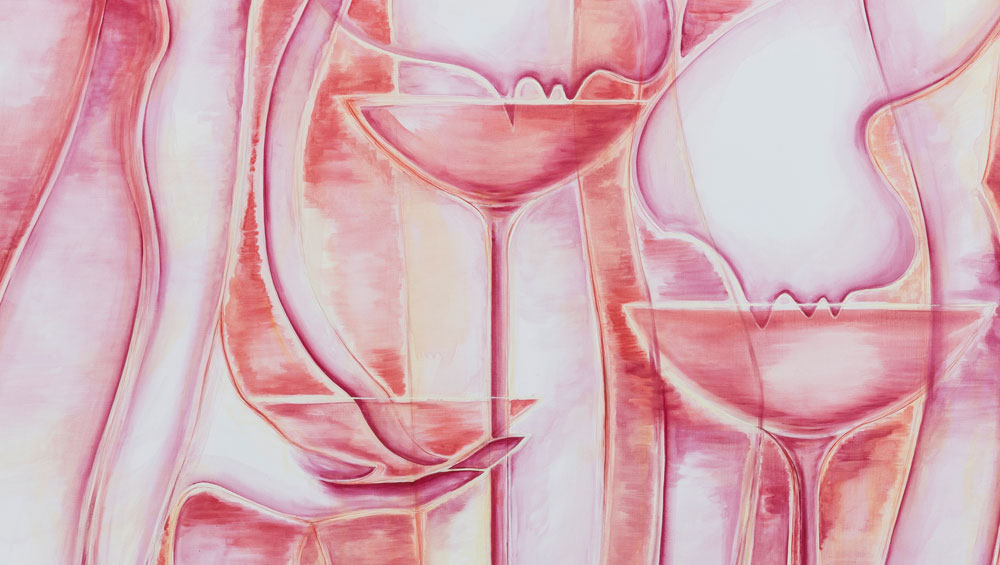
Catherine Parsonage. Suddenly Every Wednesday, 2017 (detail). © the artist.
by ROSANNA MCLAUGHLIN
I meet the painter Catherine Parsonage in Rome, having trundled my suitcase right across the centre of the old city, past the Pantheon and some ruins that have now become a cat sanctuary and into the Testaccio neighbourhood. Parsonage greets me on the street in front of her apartment, and as I peel the shirt from my back, which has turned sticky under the midday sun, I take in her accent: an unexpected hit of Wirral on the banks of the Tiber. She flicks her cigarette into the gutter (one of many she smokes during the course of the afternoon) and leads me upstairs. Over coffee and breads from the local delicatessen, we discuss the importance of sweat patches, the proximity of humans to monstrosity, and the role that alcohol and desire play in her paintings.
Parsonage was born in 1989 and did a BA in fine art at Manchester School of Art before doing an MA in painting at the Royal College of Art in 2011-13. She moved to Rome from London in October 2016 when she was awarded the Sainsbury Scholarship in Painting and Sculpture at the British School in Rome, and remained in the city when the scholarship ended last September. She is compelling company. As I recline on the sofa, she darts about the room, moving from windowsill to kitchen to sofa and back again, one minute reaching for a book or an essay or a quote – Jean Genet, Susan Sontag and Gertrude Stein are mentioned frequently – the next for tobacco, apparently propelled by an irrepressible cocktail of intellect and energy.
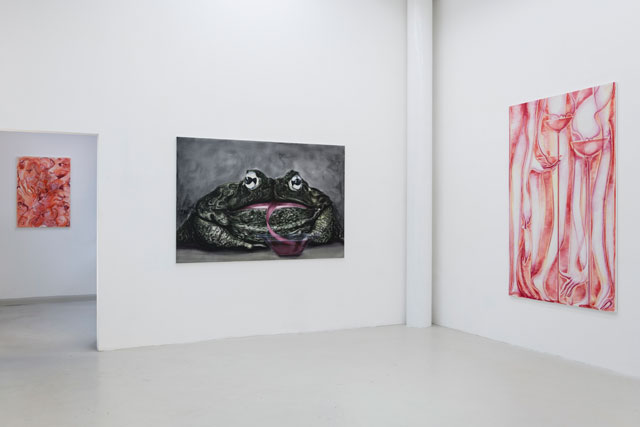
Catherine Parsonage. Convivium, installation view, Bosse and Baum, London, 2017. Image courtesy Bosse and Baum.
The desire to express more, connect more and feel more is central to her latest paintings, which teeter between orgiastic joy and drunk-in-the-gutter excess. In the winter of 2017, I attended Parsonage’s solo show Convivium at Bosse and Baum in London. To enter the exhibition was to feel you had joined a surreal dinner party of uninhibited and inebriated guests. Six paintings were on display, each produced in a different register and scale: an exploding volcano, some spindly creatures sucking liquid out of glasses, and a giant toad called Alice, which is where our conversation starts …

Catherine Parsonage. Alice, 2017. Acrylic on canvas, 183 x 122 cm. © the artist.
Rosanna Mclaughlin: I would like to begin by asking you about Alice (2017), the painting of a toad drinking red liquid from a glass, which you showed as part of Convivium in London. That painting has such presence! Where did the name Alice come from?
Catherine Parsonage: It comes from a short story by Steven Millhauser called A Visit (1997) that I listened to on the New Yorker fiction podcast. It’s a totally bizarre magical realist story and one that I listened to many times and kind of absorbed before it became a painting.
It’s about a guy who goes to visit an old college friend at his isolated dilapidated house. When he arrives, he is greeted by his love-struck friend who is desperate to introduce his wife. When she appears, we meet Alice – his toad wife.
Throughout the story there are these incredible encounters: amorous glances between the couple, a dinner where she licks chunks of cheese into her mouth, and then the sound of a running bath, splashing water and, finally, climactic toad-love. Both the reader and the narrator slip between different emotions – confusion, repulsion, and then, finally, even jealousy. While making the painting, I was thinking about the relationship between man and nature (or animal) and how during moments of intensity, we can all slip into bestial versions of ourselves.
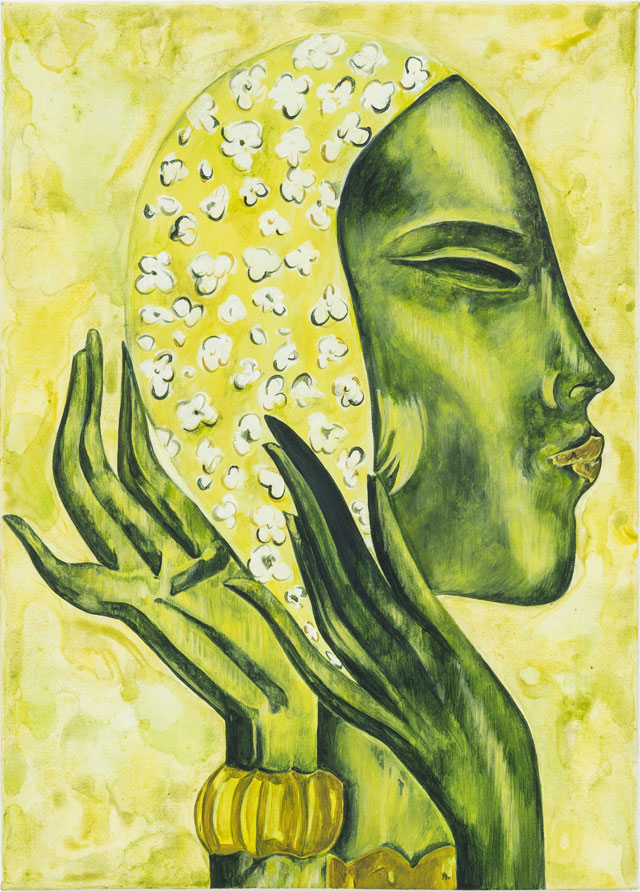
Catherine Parsonage. Myrtle, 2017. Acrylic on canvas, 25 x 35 cm. © the artist.
RM: A lot of the paintings in Convivium have female names. There is also a portrait of a woman with flowers in her hair, titled Myrtle (2017), and Emma (2017), a painting of a red volcano. Is there a level on which you can see each work as a character with its own individual personality and style?
CP: Yes, exactly that. Some of the paintings with female names were titled after literary protagonists, such as Emma from Susan Sontag’s 1992 novel The Volcano Lover, whereas the portrait Myrtle references some of the historical rituals that surround the Roman convivium. Apparently, before the guests began their evening of drinking, they would put myrtle garlands around their heads to prevent a hangover the next day.

Catherine Parsonage. Emma, 2017. Acrylic on canvas, 25 x 35 cm. © the artist.
RM: I’ve never heard of that technique before … perhaps it wasn’t effective enough to make it in to the modern day?
CP: I would have been wearing a garland last night if it was!
RM: Returning to Alice – female monstrousness is something of a motif throughout much of your work. Is this tied up with the liberation of a certain kind of female eroticism?
CP: The idea of a body spilling into the bestial or becoming carnal is not something I think about as specific to those who identify as female. The first time these thoughts really crystallised was after a conversation with the artist Tomaso de Luca, and I think that the power of the bestial body is that it can be anyone’s. The “female monster” is instead one of many archetypes of what being female is or means. It speaks to social expectations and limitations and is undoubtedly bound up with a certain female eroticism. I often reference and make paintings about literary female protagonists such as Aliceas a way to navigate – or maybe even better, get close to – some of these expectations and ideas. For example, in the painting Bad Behaviour (2017), which depicts three figures in a melting embrace of tongues and fingers, I used Mary Gaitskill’s 1988 collection of short stories by the same title as a filter to think about the libidinous woman and what it means for a woman to pursue a physical or emotional connection.
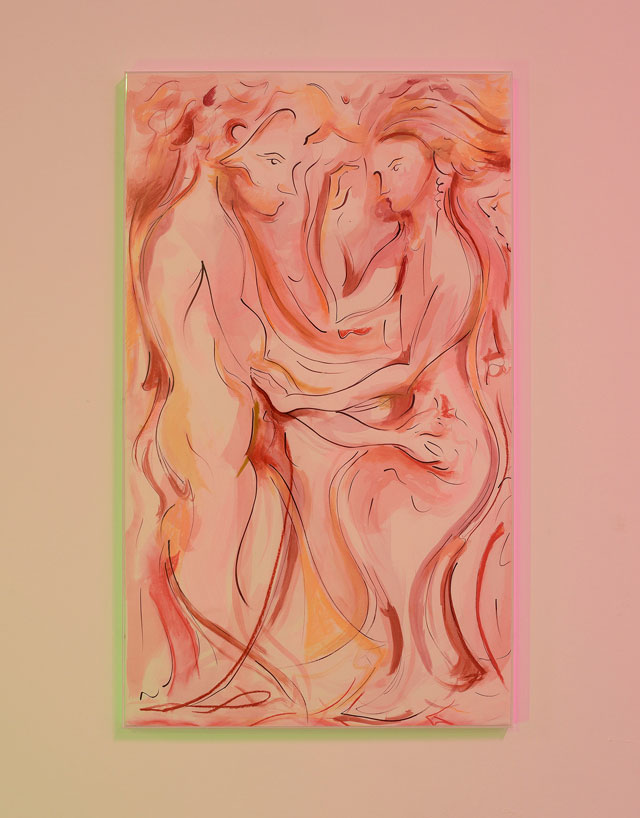
Catherine Parsonage. The mad sensitivity of skin, 2017. Watercolour, pastel on fabriano paper in perspex frame, 66 x 111 cm. Installation view, Full for It, Tomaso De Luca & Catherine Parsonage, Garbo’s, Rome, 2017. Photograph: Roberto Apa.
There are many versions of this complex, eroticised figure that I have lived with long before they came to the fore in recent work. For example, I have visited and revisited Fritz Lang’s film Metropolis (1927) and his devilish double, Maria, and Gertrude Stein’s Melanctha (1909). Stein’s novella has been described as tracing “a curve of pleasure” and, actually, I think it is this experience of, or desire for, pleasure that has led me to the notion of a female monster.
RM: Can you tell me about the significance of the title Convivium? It is the Latin word for feast or banquet, and in ancient Rome these were pretty raucous, gluttonous, orgiastic affairs.
CP: A convivium was the Roman equivalent of the Ancient Greek symposium. Over dinner one evening, a friend with an enviable talent for telling perfectly timed anecdotes and stories described the symposium to me: its rituals, its sticky games of flicking wine dregs across the table at one another, its debauchery, its poetry. So, I was thinking about the convivium as an idea that could encompass and weave together some of the strands in my paintings – the literary with the candid, the poetic with consumption and excess, but also that the exhibition could become a space for sharing wine (negronis!) and poetry and words, which is what it became during two poetry events Bosse and Baum hosted.
The image conjured by my friend’s story stayed with me for a number of months before it became the painting Suddenly Every Wednesday (2017), which features in Convivium.
RM: A painting in which flamingo-like figures suck wine from tall glasses …
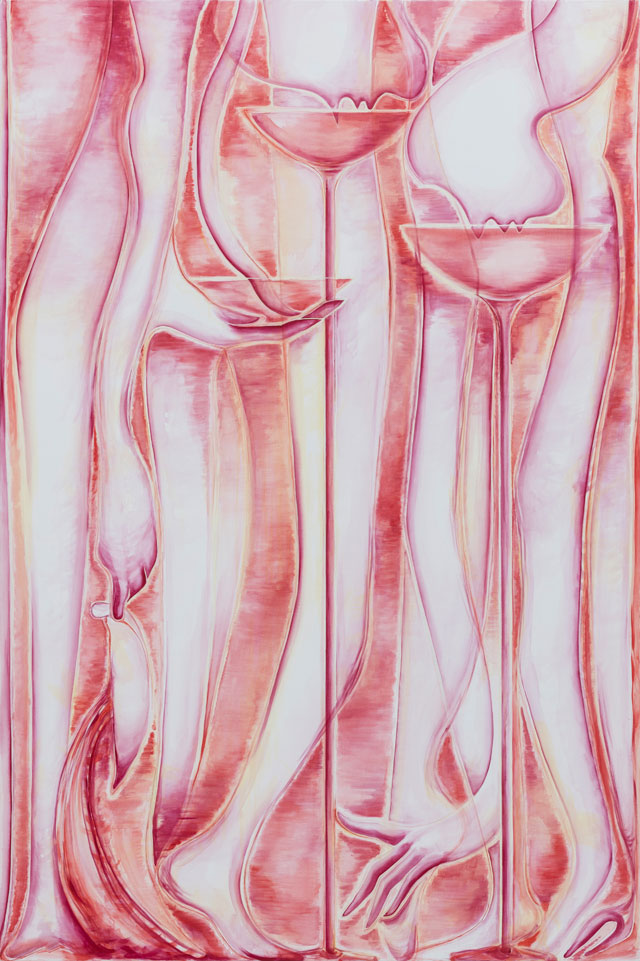
Catherine Parsonage. Suddenly Every Wednesday, 2017. Acrylic on canvas, 122 x 183 cm. © the artist.
CP: The painting takes its title from a weekly evening of poetry readings organised by the poet Jahan Khajavi at the Garbobar in Rome – Garbo as in Greta – a gay bar with a late licence. It’s a place that merged into my idea of what a convivium or symposium was or could be. Hosted by the delicious Khajavi, Suddenly Every Wednesday brings together artists, writers and poets living in the city, and those passing through, to drink and to read. And they often become as you describe: raucous, gluttonous, orgiastic affairs.
RM: Some of your earlier paintings, such as Cut and Slender Joint Alone (2013) – which was shown as part of Bloomberg New Contemporaries in 2014 – were concerned with representing the female body with very minimal, reduced lines. These works had a kind of strict elegance that is very different from the work you are making now.
CP: Those earlier paintings came from a specific place. The line wasn’t only elegant, it was also aggressive – the source material for the figures was actually some pretty tough BDSM. They derived from the experience of seeing my friend being treated in hospital and having this sensation that her body had somehow already slipped into an image of itself and had lost its bodilessness.
RM: Because she had given herself over to the realm of medicine?
CP: There is also a literal giving over of the body in terms of fluids and those kinds of things. In addition to that, there was a distancing that happened. In a super-modernist way, her body was reduced to something mechanical. That work was related to grief, to losing something.
RM: When did your painting begin to change? If the earlier works were involved in a whittling down, Convivium is concerned with excess – a great big carnal toad, an exploding volcano, canvases saturated in boozy hues. There is a hedonistic, no-more-fucks-to-give eroticism to the new works. Like that moment where you have had one too many drinks and you become dangerously uninhibited …
CP: I felt like I had exhausted the possibilities of what I could make with the process of reduction. I wanted to break things apart, let everything be available to me. When I first arrived at the British School in Rome [BSR], the work I was making felt so compressed and so distant from the things I was thinking and doing. It stopped exciting me. Around that time, the painter Ella Kruglyanskaya came to visit. I had met her previously when she came to visit the artist Alan Reid during a residency at Villa Lena in Tuscany, where we were all living and working in the middle of nowhere in the Italian countryside. In her talk at the BSR, she pointed out how all of the women in her paintings have sweat patches, that we all sweat and yet you never see that in painting. It struck a chord with me, maybe because I’m super-sweaty, so I did a talk shortly after and I talked about Ella while showing an image of me in a green Lycra catsuit at a party with huge dark sweat patches under my arms. There’s just something so interesting about bodily fluids and this idea that we should contain or be embarrassed by them somehow, or alternatively, as you say, have a no-more-fucks-to-giveattitude. Ella also talked about the attitude of the female protagonists in her paintings, and it made me think that I had removed any kind of attitude from the bodies I was painting. I knew I wanted my protagonists to have a personality, and to be more connected to what I was experiencing.
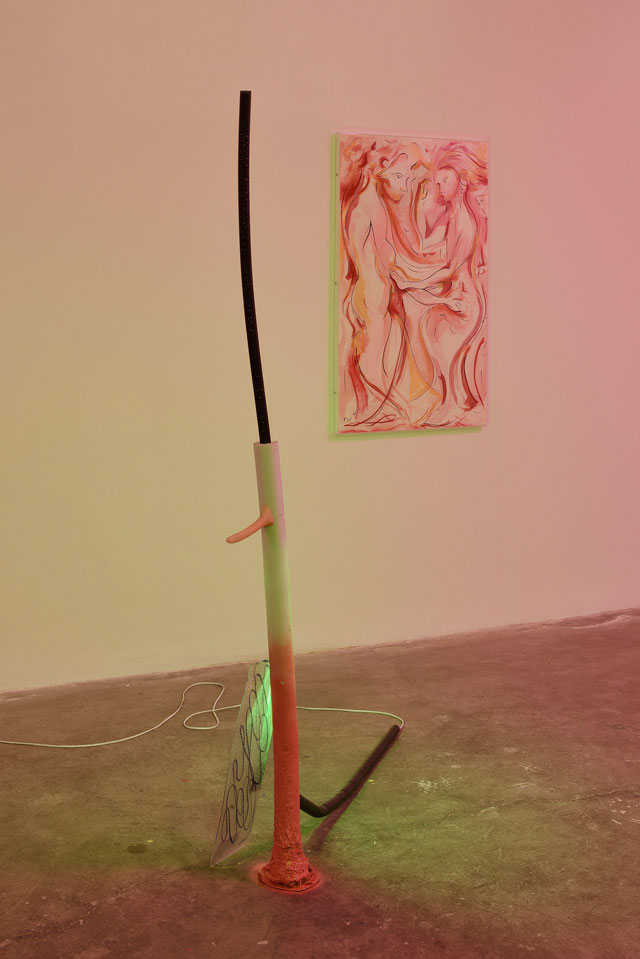
Installation view, Full for It, Tomaso De Luca & Catherine Parsonage, Garbo’s, Rome, 2017. Photograph: Roberto Apa.
RM: Has the experience of living in such a historically rich city as Rome had an impact on what you are making? I was speaking to an artist last night who said that it can be as much of a burden as an inspiration, because the history is so present and dominant on practically every street corner.
CP: When you first come to Rome, you are astounded by it. It’s entirely overwhelming, but, for good or for bad, you get used to it. I think that the shift in my work has been mainly a result of the people I have met and the experiences I have had here – the new family that you create when you move to a new place. In theory, this could happen anywhere, but there is something about the size of this city and the size of the art scene. Everything is much more compact, so relationships form quicker. In London, you can meet someone at an opening whom you may really connect with, but you might not see them again for three months. Before I moved to Rome, I was living in Clapton, my studio was in South Bermondsey and I was working in Putney. It was so hard to maintain significant day-to-day interactions. In Rome, there is a genuine sense of community.
RM: Has existing within a tight-knit art community changed the way you make things? Do you feel that you are working more collectively – if not in terms of the physical act of making, in the exchange of ideas?
CP: Definitely. Earlier this year I worked with Marco Palmieri to design a set for a performance by Jahan Khajavi at Fondazione Giuliani. I collaborated with the artist Kate Power during my time at the BSR, and the show Convivium was based around this idea of sharing. I did two events to coincide with the exhibition. Pele Cox – who was the first poet in residence at the BSR – has a collection of poems titled The Mistress Account (2015) which describes the intricate details of an affair from the mistress’s perspective. The entire sequence of poems was performed by the incredible actress Lou Broadbent, whom I also met in Rome. The second event brought together 10 different writers, including Sally O’Reilly, Fabian Peake and Suzi Feay, and, in the true spirit of the convivium, we drank about 10 litres of negroni, read poetry and shared boozy words.
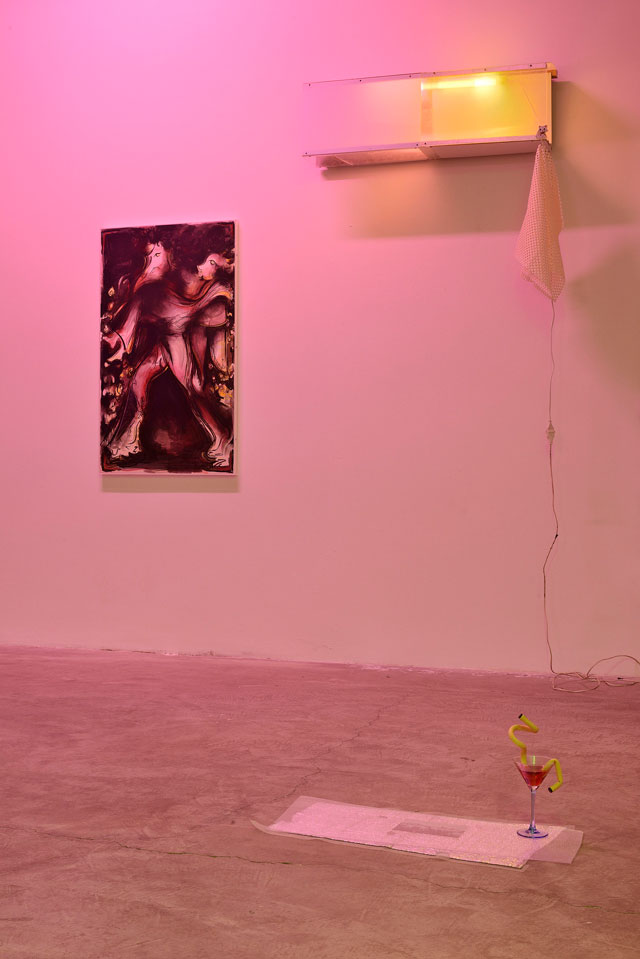
Installation view, Full for It, Tomaso De Luca & Catherine Parsonage, Garbo’s, Rome, 2017. Photograph: Roberto Apa.
RM: In June last year, you had a two-person exhibition with Tomaso de Luca at the nomadic Garbo’s Projects in Rome called Full For It, which also tipped into something of a social event.
CP: Yes, it definitely turned into a bit of a party. Full For It was a one-day show that took place in an area in the south of Rome not too far from where Pasolini used to spend his days, in a warehouse used to store incredible theatrical props and sets. One of the key elements of the exhibition was the stunning poem Honey Lamb (2017) by Sophie Robinson. It was sent to me by a friend after it was published in the White Review. I had been rolling over the ideas and the possible connects between Tomaso and me and then, when I read the poem, everything snapped into place.
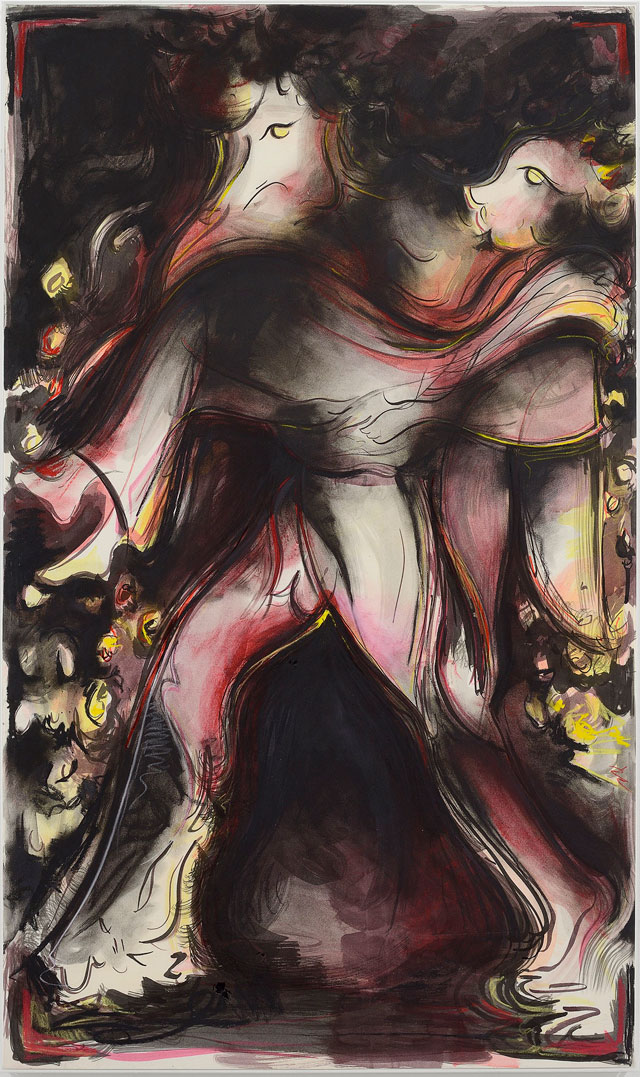
Catherine Parsonage. Carry me from Garbo's, 2017. Indian ink, pastel, oil pastel on fabriano paper in perspex frame, 66 x 111 cm. © the artist.
RM: Full For It is an amazingly evocative title. It makes me think of being so keen for something that it begins to manifest physically, that your body becomes bloated with fervour.
CP: We were talking a lot about the aesthetics of pleasure and reverie and also the hangover of modernism. The title Full For It – which came from Gertrude Stein’s If I Told Him: A Completed Portrait of Picasso (1923) – felt like it could be simultaneously propositional and anticipatory, while also being loaded, full of the potential hangover of an excessive night or of the aftertaste of a sexual encounter. It was important through our install of the show that we were setting a particular tone, creating a certain atmosphere that the works and viewers would inhabit. As the sun set outside, the cool pinks and acid-green lights we had installed inside intensified and made the pieces glow with hazy contours.
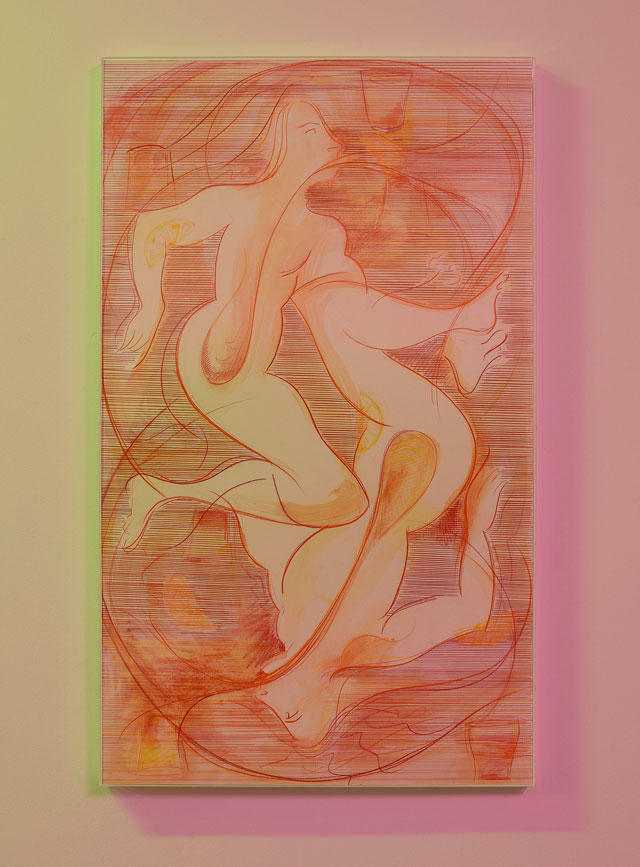
Catherine Parsonage. Campari Spring, 2017. Coloured pencil, pastel, watercolour on fabriano paper in perspex frame, 66 x 111 cm. Installation view, Full for It, Tomaso De Luca & Catherine Parsonage, Garbo’s, Rome, 2017. Photograph: Roberto Apa.
RM: In Campari Spring (2017), one of the paintings you exhibited as part of Full For It, two spinning figures appear to be vomiting or drinking, or possibly both. It seems to celebrate the hunger, openness and desire suggested by the show’s title. I started to think of this painting as a sigil for your recent work, your own personal coat of arms: bodily, carnal, excessive, shameless.
CP: I love the idea of Campari Spring being a sigil for more recent work. That piece, and the others I exhibited, all rotated around ideas of excess, of drunkenness and, importantly, of hazy encounters – all depicting two floating, vibrating figures. I’m not sure if I had this Andy Warhol quote in mind when I made Campari Spring, or whether it’s been floating around ever since, but when I think of appetite or consumption it comes to mind: “I think about people eating and going to the bathroom all the time, and I wonder why they don’t have a tube up their behind that takes all the stuff they eat and recycles it back into their mouth, regenerating it, and then they'd never have to think about buying food or eating it. And they wouldn't even have to see it – it wouldn't even be dirty. If they wanted to, they could artificially colour it on the way back in. Pink …”
During a studio visit with Miriam Goldby, she mentioned the story of Paolo and Francesca while looking at Campari Spring. In Dante’s The Divine Comedy, Paolo and Francesca were condemned to spend eternity in the second circle of hell, which is reserved for the lustful, after they had an affair and were murdered by the wounded husband. Like the figures in my painting, they are forced to remain for ever in a whirlwind where they can almost touch but never satisfy their passions again. I think this reference brings into play a lot of poignant ideas about vice, sin, lust, shame or shamelessness and judgment, which continue to simmer under the surface of more recent work.
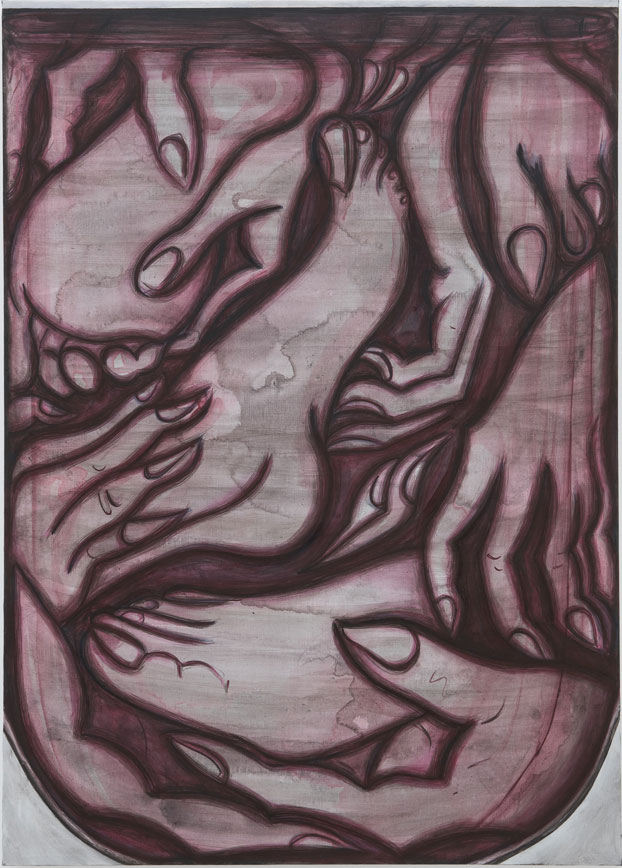
Catherine Parsonage. Decant me (foot fetish), 2017. Acrylic on canvas, 50 x 70 cm. © the artist.
RM: Speaking of vice, alcohol and the body often co-mingle in your paintings as they do in your events. Decant Me (foot fetish) (2017) depicts a glass filled with feet and wine, and in Suddenly Every Wednesday (2017) the figures are similar in shape and colour to the glasses from which they drink.
CP: I’m interested in this idea of consumption, that point of excess where self-imposed or socially imposed structures of what counts as “good behaviour” slip and melt and everything becomes more fluid. And sometimes in these moments I have very clear images of paintings that pinpoint a certain sensation. My jealous painting Acid Tongue (2017) is the result of one such image that came to me in a bar.
RM: Acid Tongue depicts a figure with a snake-like tongue that wraps around the stem of a glass. The entire canvas is bathed in a sickly shade of absinthe green. Did the image come to you complete?
CP: Like with the painting Suddenly Every Wednesday, the image came to me almost complete, and I lived with it for a while, so it almost felt like a memory of an artwork I had actually experienced “in the real”. Then it went through a series of drawings and watercolour sketches until what I was making resembled what my imagination had concocted.
RM: I’m intrigued to know how you make your work. The paintings in Convivium were produced in a range of styles. Some read more like motifs, others landscapes or portraits. Was there a dramatic difference in the process of making individual paintings?
CP: Recently, while I was doing some teaching, a student said to me:“I just give the painting what it wants, what it needs.” I know this sounds romantic and has probably been said in many ways by many macho painters over the years, but it resonated with my approach to making Convivium. When I was thinking about the specific literary references or anecdotes for each painting, the sensations that I wanted to communicate seemed to demand a particular way of making – hence the stylistic shifts between them.
Alice was the first painting I made for the exhibition Convivium, and she lived with me for a really long time. The others happened around her. She became this lovely anchor for the other works, and I think a strong sense of that was transferred into the final exhibition.
RM: You currently have work in the group exhibition Searching for Myself Through Remote Skins at Renata Fabbri gallery in Milan. Can you tell me about what you are showing?
CP: The exhibition is curated by Bianca Baroni and brings together the work of nine female artists. It touches upon ideas in the Luce Irigaray essay Perhaps Cultivating Touch Can Still Save Us (2011).I am exhibiting two paintings, both in hazy red and yellow hues: one of an ear and a small painting of a spider on the nape of a woman’s neck with pearls or spider eggs wrapped around it.
I was loosely thinking about two books while making them: Virginia Woolf’s Orlando (1928)and Jean Genet’s Our Lady of the Flowers (1943), and their densely non-linear, dreamlike passages, in which sexuality, gender and morality’s edges become blurred and slippery. When I read the Irigaray essay, something in her description of Dionysus connected with these books: it was liquid, flowing, with a sense of continuous motion, but also concerned with edges, limits and skin.
• Catherine Parsonage’s work can be seen as part of the group exhibition Searching for Myself Through Remote Skins at Renata Fabbri gallery in Milan until 7 July 2018.